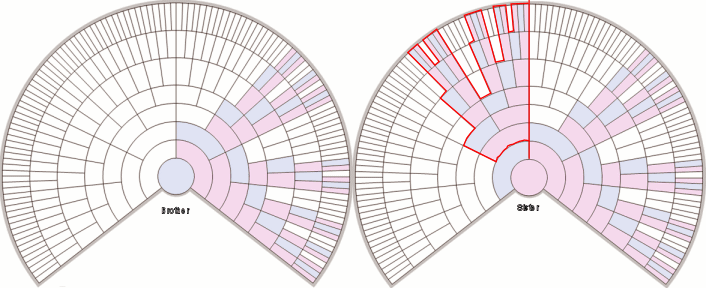![]()
Using DNA genetic tests can help you fill in the gaps in your genealogy and help when you reach a 'brick wall'. It can be, but need not be expensive.
Before we start - let me come clean. I don't consider myself an 'expert' in DNA testing and have no professional qualifications in it. I do, however, have the ability to read, understand (I think) and explain a very complex subject to others.
Over the last few years the use of DNA testing has made it's appearance in genealogy. 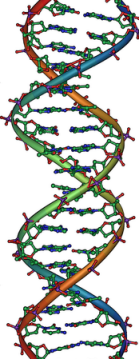 Using it it has been established that we are all descended from a man who lived 60-90 thousand years ago (referred to as Y-chromosomal Adam) and a woman who lived 150-190 thousand years ago (Mitochondrial Eve). You will quickly notice that this 'Adam' and 'Eve' lived thousands of years apart and cannot be the Adam and Eve of the bible. Neither of them was the first human they are just the most recent people from whom all living people can trace their DNA. Other people living at the same time did not produce surviving descendants whose DNA can be traced today.
Using it it has been established that we are all descended from a man who lived 60-90 thousand years ago (referred to as Y-chromosomal Adam) and a woman who lived 150-190 thousand years ago (Mitochondrial Eve). You will quickly notice that this 'Adam' and 'Eve' lived thousands of years apart and cannot be the Adam and Eve of the bible. Neither of them was the first human they are just the most recent people from whom all living people can trace their DNA. Other people living at the same time did not produce surviving descendants whose DNA can be traced today.
Lost you yet? Let me explain more:
Some 'facts' you can take for granted are -
- The basic chemical which all living things are made from is DNA, an acronym of Deoxyribonucleic acid. This chemical is a highly complex and huge molecule arranged in the shape of a double helix
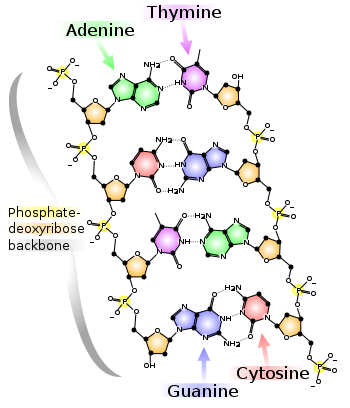 This diagram shows a very short section of the helix straightened out. If you use a little imagination you can picture it as like a ladder. It's made up of carbon atoms - the black dots; Oxygen atoms - the 'O's; Nitrogen atoms - The 'N's; Phosphorous atoms - the 'P's; Hydrogen atoms - the 'H's. In some places, where there are three thin lines going to a carbon atom (black dot), a hydrogen atom is also attached but is not shown to make the diagram clearer. As you can see the 'rungs' of the ladder are made up of four different sections called Adenine, Thymine, Guanine and Cytosine. These are are known as 'bases' and often represented by the letters A, T, G and C. When these chemicals link together Adenine always links to Thymine and Guanine always links to Cytosine. A pair of these bases make a 'rung' on the ladder. This short section of DNA might be recorded as 'ACTG' because from the top left the sequence is Adenine, Cytosine, Thymine and Guanine.
This diagram shows a very short section of the helix straightened out. If you use a little imagination you can picture it as like a ladder. It's made up of carbon atoms - the black dots; Oxygen atoms - the 'O's; Nitrogen atoms - The 'N's; Phosphorous atoms - the 'P's; Hydrogen atoms - the 'H's. In some places, where there are three thin lines going to a carbon atom (black dot), a hydrogen atom is also attached but is not shown to make the diagram clearer. As you can see the 'rungs' of the ladder are made up of four different sections called Adenine, Thymine, Guanine and Cytosine. These are are known as 'bases' and often represented by the letters A, T, G and C. When these chemicals link together Adenine always links to Thymine and Guanine always links to Cytosine. A pair of these bases make a 'rung' on the ladder. This short section of DNA might be recorded as 'ACTG' because from the top left the sequence is Adenine, Cytosine, Thymine and Guanine.- Looking at the section from the other side it might be recorded as TGAC but to a geneticist this would mean the same because as I said - 'When these chemicals link together Adenine always links to Thymine and Guanine always links to Cytosine.'
- In human DNA there can be as many as 220 million 'rungs' in a DNA 'ladder'.
- Where a particular 'rung' on a DNA ladder is different between two individuals this is called a single-nucleotide polymorphism or SNP (pronounced 'snip')
- There are areas of DNA which don't seem to do anything useful (as far as we know). Changing them seems to have no effect. These areas are called junk DNA. Within these areas there are well known sections called markers which have been given code names. It is these areas which are tested in genealogical DNA testing.
- Often the pattern of 'rungs' on the DNA ladder repeats a sequence. For example the pattern TCTA may repeat several times in a particular area of DNA known as the DYS391 marker. The TCTA section is called a short tandem repeat or STR
- The number of STRs in a marker area of DNA can be counted and is recorded for example as DYS391=7. This means in the DYS391 area of junk DNA the TCTA sequence repeats seven times.

In my own particular case this marker repeats 11 times. More about the markers. - The order in which the rungs appear in the ladder is what makes us different from each other. In identical twins the order would be almost identical. 99.9% of our DNA is the same in all humans. We share 96% of our DNA with chimpanzees, 85% with mice and about 50% with a tree.
- Different living things also have different lengths of 'ladder'
- DNA is found tightly wound up in chromosomes. In the nucleus of a normal human cell there are 23 pairs of these making a total of 46. These are big enough to be seen with a powerful optical microscope. They were first noticed in 1848.
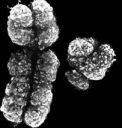 One of the pairs of chromosomes determines the sex of a child. Because of their shape these chromosomes are known as X and Y chromosomes. Females have an XX sex chromosome and males have a XY chromosome. The XY chromosome pair is shown in the picture on the left.
One of the pairs of chromosomes determines the sex of a child. Because of their shape these chromosomes are known as X and Y chromosomes. Females have an XX sex chromosome and males have a XY chromosome. The XY chromosome pair is shown in the picture on the left.- Outside the nucleus, there are bodies called 'mitochondria' that generate energy for the cell. Within every mitochondrion there is a copy of a forty-seventh chromosome. The DNA in that chromosome is called 'mitochondrial DNA'.
- A child gets his/her nuclear DNA from both parents The mother always provides an X chromosome the father either provides an X chromosome; in which case the child will be female; or a Y chromosome; in which case the child will be male. Mitochondrial DNA always comes from the mother.
- There are two main genetic tests available to genealogists.
- One test - the Y-chomosome STR test - uses the Y chromosome to trace paternal line. It can only use DNA from a male family member so ladies - ask your brother/father/paternal cousin, uncle or grandfather to provide the DNA sample needed.
- The other test - the mtDNA test - uses mitochondrial DNA and is used to trace the maternal line. It is available to either sex.
- Three other genetic tests are possible; the Autosomal DNA test, which tests the 22 remaining pairs of chromosomes; the X-chomosome STR test, which tests the X chromosome - the female 'sex' gene. Both of these tests can be used on either sex and tell you about all your lines, not just the paternal and maternal lines. At the moment they tell you little beyond your Great Grandparents though, the early results were difficult to understand and had up to a 15% error rate. Finally you can have Whole Genome testing done, which is usful medically as well as for genealogy.
How is the DNA sample collected?
Either a cheek swab or a mouthwash is used and sent to the DNA lab. Both are painless and easy to do at home.
What will the test tell me?
The Y-chomosome STR test will tell you your direct male line only - usually, unless there has been an adoption, or illegitimacy, the line of your surname. Using it you can tell if two people with the same surname are from the same family by comparing the charts of results. If they are identical then the people share the same male ancestor. If they differ by one or two markers then there is a remote ancestor. If there are three or more differences their common ancestor is so remote that the two are considered unrelated. Of course the greater the number of markers tested then the more accurate the test will be.
The chart below shows examples. This one tests 21 markers:
| Y-DNA STR Markers (differences from James Foggon highlighted) | |||||||||||||||||||||
| Person | 19 |
385a |
385b |
388 |
389i |
389ii |
390 |
391 |
392 |
393 |
425 |
426 |
437 |
438 |
439 |
460 |
461 |
462 |
GATA A10 |
GATA C4/ DYS635 |
TAGA H4 |
| James Foggon | 14 |
11 |
17 |
12 |
13 |
28 |
24 |
11 |
14 |
13 |
12 |
10 |
15 |
10 |
12 |
10 |
12 |
12 |
12 |
27 |
23 |
| George Foggon | 14 |
11 |
17 |
12 |
13 |
28 |
24 |
11 |
14 |
13 |
12 |
10 |
15 |
10 |
12 |
10 |
12 |
12 |
12 |
27 |
23 |
| John Foggon | 14 |
11 |
17 |
12 |
13 |
28 |
24 |
11 |
14 |
13 |
12 |
10 |
15 |
10 |
12 |
10 |
12 |
12 |
12 |
27 |
23 |
| Andrew Foggin | 14 |
11 |
17 |
12 |
13 |
28 |
24 |
11 |
15 |
12 |
12 |
9 |
15 |
10 |
11 |
10 |
11 |
12 |
12 |
17 |
23 |
Peter Fogg |
14 |
11 |
16 |
12 |
13 |
28 |
24 |
10 |
14 |
13 |
12 |
10 |
15 |
10 |
12 |
10 |
12 |
12 |
12 |
27 |
23 |
| David Foggan | 14 |
11 |
17 |
12 |
12 |
28 |
24 |
11 |
14 |
13 |
12 |
10 |
15 |
10 |
12 |
10 |
12 |
12 |
12 |
27 |
23 |
The top three in the table, James, George and John Foggon have the same markers. This means they are likely to share a common male line with a common ancestor within eight generations.
Andrew Foggin differs in six markers and is unrelated.
Peter Fogg differs in two markers. Since these 21 markers are likely to mutate every 12 generations on average this means that with two markers different Peter and James probably shared a common male line ancestor within 33 generations.
David Foggan has one marker different which means his relationship is closer. He probably shared a common ancestor within 20 generations.
Calculating the point where a common ancestor exists is not by any means straightforward since the different markers mutate at different rates. For example the DYS426 marker has a mutation rate of 0.0110 in some cases and the DSY449 has a mutation rate of 0.0989; about 9 times greater. To complicate things the markers can mutate at different rates between different families. Some firms take the easy way out and assume an average mutation rate of 0.021 mutations per generation, others consider individual markers. Since the order of the markers DYS464a, b, c d etc markers is not shown by the tests these markers are not usually used in determining the most recent common ancestor.
There is a much more detailed explanation of the Y-chomosome STR test to be found at DNA Heritage's site The diagram below shows the related people in a family who would share Y-dna.
Assuming 'you' are male: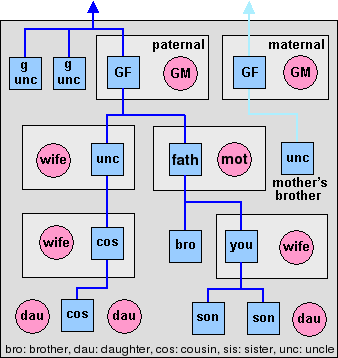 Image from Sorenson Molecular Genealogy Foundation
Image from Sorenson Molecular Genealogy Foundation
If you are female and want to do an Y-chromosome test to trace your paternal line then ask a brother, father, paternal uncle or grandfather to supply the DNA sample.
Mitochondrial DNA (mtDNA) comes from DNA outside the cell nucleus and is passed down from the mother only to all her children regardless of their sex. This means that in the same way as the Y chromosome test will tell a man about his paternal line, the mtDNA test will tell either sex about their maternal line. It tests DNA passed from mother to child.
Mitochondrial DNA is different from nuclear DNA in that it is arranged in a closed circle rather than in an open ended spiral. It's also much shorter being comprised of 16,569 base pairs (the rungs on the DNA ladder) rather than the 220 million in nuclear DNA.
Assuming 'you' are female:
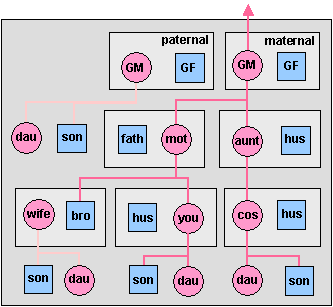 Image from Sorenson Molecular Genealogy Foundation`
Image from Sorenson Molecular Genealogy Foundation`
If you are male then your DNA sample will still tell you your maternal line but it will be different to that of your children.
The mtDNA is more stable than Y-chomosome DNA with variations appearing every few thousand years. Because of that you will find many more individuals sharing the same results making it less useful. It can, however, trace your maternal line back to groups of people descended from about 30 individuals located in particular areas of the world. These groups are known as haplogroups. In Europe there were originally found just seven of these known as the 'seven daughters of Eve' (There are now nine)
What will the test tell me?
The mtDNA test: Since mitochondrial DNA is far more stable than Y chromosome DNA and as a result you are unlikely to see variation within 500 generations. This means that two people with the same mtDNA results will be related but not necessarily related within genealogical time. It's just as possible for a common ancestor to have lived 10,000 years ago as for that ancestor to have lived in the last 400 years. What the result will tell you is the deep ancestry relationships and the possible origin of your family. Whilst this is not very helpful in making that missing connection, most people find the deep ancestry information it provides of interest.
Autosomal DNA testing is beginning to make progress as testing becomes less expensive. Databases listing it are still limited. As a result there is some variation in the results obtained over time and between firms. This DNA is responsible for hair, eye colour and other physical features as well as ethnic group(this might be important to some people but to a genealogist it's about as useful as telling you if they are blond or brunette). Since it is passed down by both parents it covers all of your ancestors. There is some concern as to the accuracy and usefulness of the results.
MyHeritage now offers an autosomal Family Finder DNA test which they say is suitable for finding common relatives in the last 6 generations. They also say it can give you a better idea of ethnic origins.
The X-chromosome is passed down by both parents of females but is not passed down from father to son:
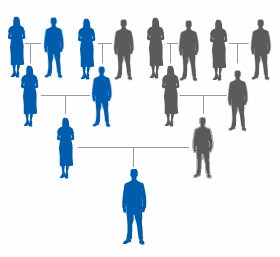
What is interesting about this genetic test is that by having the DNA of a brother and sister tested you will be able to isolate the DNA of a significant section of your paternal grandparents - See the chart below to explain this:
Pink represents female and blue, male. For a brother and sister the results will be identical apart from the red highlighted area which couldn't be uniquely identified by other methods.
The disadvantage of X chromosome testing is that few centres offer this as an option since it's a relative newcomer to the field.
Whole genome testing
New advances in nanopore sequencing technology mean that your entire DNA sequence can now be worked out. Currently this costs about $1,000 but the price can be expected to drop. At the moment I know of no genealogical sites which make use of this but it's a matter of time and you can expect the price to drop.
Using whole genome testing you get all the genealogical tests at once and they can be used for working out health risks as well as genealogy. Interpreting the results would be a major task though.
Concerns over genetic testing
- Costs and accuracy
Genetic testing prices vary tremendously as do the tests themselves. In general the more markers which are tested - the more expensive, and accurate the tests tend to be. I've endeavoured to put together a table which shows the prices of the main firms which do genealogical DNA testing so that you can compare them quickly. Prices are as of january 2009. It is inevitable that prices will come down and accuracy will improve over time. One source I found is free! - Lack of information about the results
Many people are disappointed when they get the results that they find little information they can understand. This varies tremendously between firms. The simple answer to this is to ask to see a sample result before you buy and to research the technology first. If you've read this far - you've already done that. - Privacy
Could this stop me getting insurance? It's now against the law for insurance companies in some countries to refuse or increase the premiums of someone on the basis of genealogical genetic testing.
I don't want everyone to know that!
In which case you probably have not made your family tree research by non-genetic means public either ...and are not getting very far.
I might find an ancestor was adopted or illegitimate.
...and your point is? If this is the case genetic testing may provide your only answers and you are probably not interested in genealogy anyway. There is a further article on genetic privacy here. - It only tells me real information about two of my lines
You will get detailed information about the maternal and paternal lines. However most genealogists are in touch with cousins who have different maternal and paternal lines. Using their results will add to your genetic tree. You will probably need to persuade them to take advantage of the free testing service. - I might find I have some awful disease!
Genetic testing done for genealogical research tests areas of your DNA which are unlikely to tell you about genetic diseases. Even if you did get such a result - isn't it better to know about it so you can get treatment before it becomes a problem?
